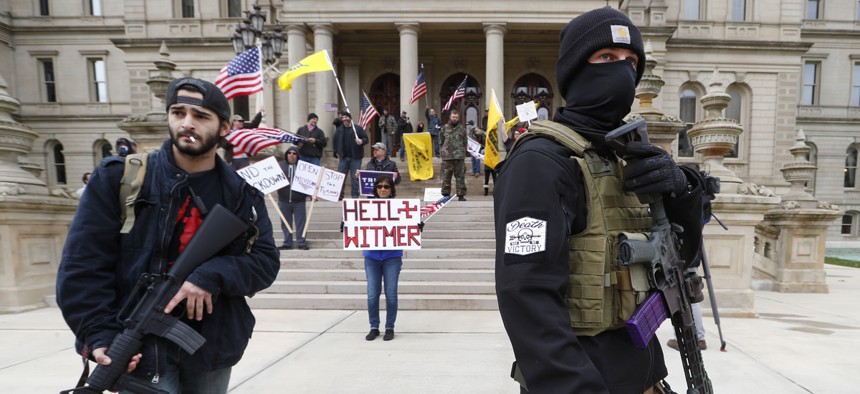Militias Direct Coronavirus Anger at State and Local Governments

Protesters at the Michigan State Capitol in Lansing. The protests in the state have been organized in part by state militia groups. AP Photo/Paul Sancya
Frustrated by the pandemic measures imposed by governors and local leaders, militia leaders have been part of organizing protests and say they are aided by an influx of new members.
At protests of stay-at-home orders at state capitols, they have been some of the most striking participants: men dressed in military-style garb, often carrying long guns. In many cases, they are members of militia groups, which have been active leaders in the movement against lockdown measures aimed at containing the coronavirus.
Josh Ellis, the leader of American Revolution 2.0, an Illinois-based militia group leading national protest efforts, said militias are banding together like never before and growing as a movement. The perception that militias are composed of “gun-toting mountain people” or reserved for far-right conservatives is shifting, Ellis said. “People are starting to wake up.”
Local militias still aren’t very big, but if they are expanding as leaders say they are, the current trend would follow a recognizable pattern seen during other periods of high anxiety, said Mark Pitcavage, a researcher at the Anti-Defamation League’s Center on Extremism. Interest in these fringe organizations has swelled during similar situations, including the period between 2008 and 2011 when Pitcavage said the recession made people “more susceptible to extremist movements.” Now, a pandemic, an acrimonious upcoming national election, and the rise of social media channels like YouTube and Facebook, where many militias organize, have made finding them easier than ever.
And while militias traditionally focused their organizing to protest the federal government, that isn’t the case right now. The choice at the federal level to take a more hands-off approach to the pandemic was “exactly what it should have been,” Ellis said. Instead, many militias have a different target: the state and local governments imposing restrictions to try to contain the coronavirus.
The buildup to pivoting their focus away from the national government and toward state and local governments has been a few years in the making, Pitcavage said. In 2016, many militia groups showed support for Donald Trump during his campaign—a first in movement history, as mainstream political candidates more often earn the ire of the groups. Though there had been militia support for minor candidates like Pat Buchanan and Ron Paul, a militia-backed candidate had never been the nominee for a major party.
When Trump’s signature anti-establishment rhetoric arrived in the White House, militias were posed with a dilemma. “It’s hard to maintain your passion and anger against the federal government when the person at the head of it is someone you love,” Pitcavage said. “So what we see now is groups looking for other things to energize them—like state red flag laws.”
State gun laws did spur protests from groups like the one Ellis runs, which The Guardian recently reported has links to extremists on the far-right (Ellis denied that the group has a partisan bent and said it is open to people of all political persuasions). But the pandemic presents a more universal situation for militias to organize around—and clear villains to position themselves against. Governors (and mayors to a lesser extent) are drawing scorn from militias for their stay-at-home orders and limitations on freedom of movement, which they see as an unconstitutional overreach of state authority. “[Governors are] saying ‘we’re going to protect you.’ The hidden message in that is that you’re too stupid to do it yourself,” Ellis said. “I don’t think Americans are that stupid. We figured out the flu, SARS, MERS, and H1N1. There’s a learning curve, sure, but we as Americans have to figure it out.”
The way Ellis sees it, in his state, Illinois Gov. J.B. Pritzker, a Democrat, “let power go to his head.”
The militia movement’s ire isn’t directed only at Democratic governors. Idaho‘s Republican governor Brad Little has also faced pushback from militia leaders in the state, long known to be hotbed for anti-government sentiment. Ammon Bundy, a member of the family that has been engaged in several armed standoffs with the federal government, took to Facebook on multiple occasions in the past few months to express his displeasure with Little’s decision making. In one video posted in late March, Bundy chafed against the imposition of a statewide self-isolate order that banned gatherings. “The last time it was illegal to meet together as a people on this land was before the Revolutionary War,” he said. “It does not matter what is most safe or not, what is good or not. Because, in this case, the government does not have the right to do what they’re doing.”
More recently, Bundy led followers to protest outside the home of a police officer who had arrested a woman for refusing to leave a shuttered public park. The purpose, according to Bundy, was to put the officer “on notice.”
"We must do everything we can with the mechanisms that have been given us to try to correct these matters,” Bundy said at the protest. “and if they will not correct, then other measures may be taken.”
The Oath Keepers, one of the largest anti-government groups in the militia movement, has also shown their distaste for police and National Guard soldiers who enforce lockdown measures. The group, which is made up largely of former and current military members, police officers, and first responders, has urged active duty law enforcement to stop policing the anti-lockdown protests that the Oath Keepers have been instrumental in planning. “Police in the U.S. need to realize they stand at the precipice of losing the trust, support, and protection of millions of American patriots,” the group wrote on Twitter after a protest in California on May 2. “They must reverse course and refuse unlawful orders, or risk being declared domestic enemies of the Constitution.”
Brian Levin, the director of the Center for the Study of Hate & Extremism at California State University, San Bernardino, said that government officials and law enforcement will need to carefully watch this movement as frustration grows with pandemic measures. The Center issued a “general conflict” advisory for state and local governments in April, and Levin said that states should be on the lookout for places where people congregate that could become tinderboxes for violence, like unemployment lines, hospitals, city halls and closed beaches.
“Officials have to be aware of the unique ways this pandemic is putting people under stress and try to respond in a way that's empathetic rather than relying solely on enforcement,” Levin said. “What they shouldn't do is let violence catch them off-guard just because their city hasn’t had a large protest yet. We can’t afford officials who are ignorant to movements that might seem weird and arcane, but could end up on the steps of city hall next week.”
The key task now for law enforcement is to “separate the wheat from the chaff,” Pitcavage said. There have been reports that some Facebook groups are coordinating a violent revolution, but “just because someone starts a Facebook group, doesn’t mean they’re actually organizing a civil war,” he said. “Lots of people have extreme beliefs, but don’t plan to do anything illegal.”
Instead, some might ratchet up their online tactics. For example, the Washington Three Percenters, a group that has been called a militia but whose members reject that label, started posting the names, emails, and phone numbers of state residents who file complaints about businesses that reopen in violation of the state’s stay at home order. “Want to snitch on your neighbor? Don’t expect to hide behind [your] computer screen,” a post on the group’s Facebook page said.
Some have argued that law enforcement should consider breaking up protests organized by militia groups in case they lead to violence. But that’s not an easy call to make, Pitcavage said, especially considering that the right to assemble is constitutionally protected. If protests violate state orders that bar gatherings over a certain size, law enforcement will have to “engage in a tough calculus,” considering what Pitcavage considers to be the four most important factors: maintaining public health, enforcing the law, respecting individual rights, and de-escalating those who might engage in violence. “You don’t want to go too far one way or the other,” he said.
More generally, Levin worries that the long-lasting scars left by the coronavirus and the economic downturn will spur a broader shift toward extremist beliefs about the government. “I think this pandemic will create a class of people on the far left and the far right who are just anti-society,” he said. “They’ll just want to tear it all down.”
Emma Coleman is the assistant editor for Route Fifty.
NEXT STORY: How New York Explains the Other 49 States






